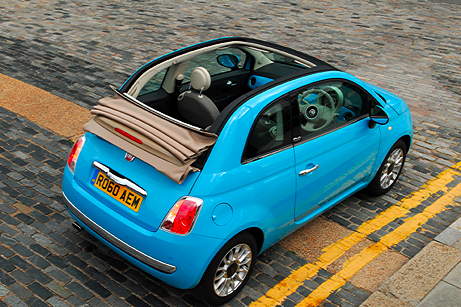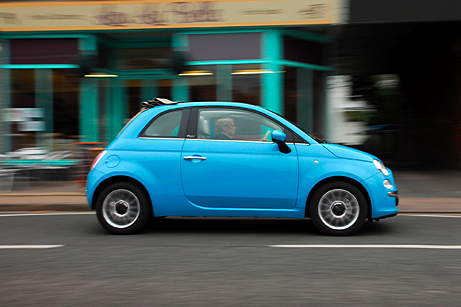
Fiat has always been good at small cars. The original Dante Giacosa-designed Fiat 500 'Topolino' sold more than half a million copies between 1936 and 1955, and the Nuova (new) 500 of 1957 found well over three million buyers in its 19-year production run. While the new 500, introduced in 2007, is a very different kind of car it has proved just as successful, the 500,000th car being built early in 2010.
Despite its looks, which closely follow those of the 1950s car, the new 500 is as different as it could be. It is a different size, it has a different mechanical layout, and its position as a fashion item attracting trendy buyers contrasts with the utilitarian nature of the 500s of yesteryear. But in the last year the 500 has acquired a new two-cylinder engine, the TwinAir, which brings it closer to its twin-cylinder forebear. More importantly this innovative engine (which was awarded International Engine of the Year in May 2011) promises to give the 500 economy, emissions, performance and refinement advantages.
We tested the TwinAir-powered 500C, the soft-top version introduced in 2009, which has a fold-back fabric roof - again bringing back memories of the folding roof of the 1950s 500.
Style and Engineering: retro style, but modern underneath
It's the cheeky and cheerful throwback styling which attracts many buyers to the little Fiat, in both fixed and folding roof versions, though this generation of 500 isn't quite as little as its predecessors. The new car weighs twice as much as the old, and at 3546mm long and 1627mm wide it is 576mm longer and 307mm wider than the 1957 500, making it an altogether more substantial car. The retro looks mostly work well, though as with many modern cars the 500 can look heavy in side view, as though it's too big for its wheels. The Abarth 500, on wheels an inch or two larger in diameter, is visually better balanced as a result.
The folding roof of the 500C is different to a conventional convertible roof, and closer in concept to the fabric sunroof which was a feature of the 1950s 500. The edges of the roof and the rear pillars are fixed, but the centre part of the roof is a fabric panel which can be electrically folded part-way back to act like a fabric sunroof, or it can be folded all the way to the rear for the maximum of fresh air.
Under the retro skin, the Fiat melds together absolute orthodoxy and state of the art innovation. The body, structure and mechanical layout are conventional: the 500 has a unitary steel structure and the rear engined, rear drive layout of the old 500 makes way for what is now a conventional small-car drivetrain layout. It was Fiat that set this pattern for front-engined, front-wheel drive drivetrains with the 128 in 1969 - the first car with the layout of transverse engine, end-on gearbox and unequal length driveshafts, and MacPherson strut front suspension.
In fact the 500 uses the same platform as its older brother the Panda and also the Ford Ka, both of which are more conventionally styled superminis. Where the latest 500 innovates is under the bonnet.

The turbocharged, two-cylinder TwinAir engine comprehensively outguns the normally aspirated 1.2-litre, four-cylinder eight-valve petrol engine also offered in the 500. The TwinAir unit is shorter, lighter, torquier and more powerful, yet also performs better in emissions tests and returns lower fuel consumption figures.
Fiat's aim was to deliver the refinement of a four-cylinder engine from this two-cylinder unit, and to achieve this the TwinAir unit has a balance shaft which runs (in needle roller bearings, to reduce friction) at the same speed as the crankshaft.
The TwinAir unit was the first engine designed specifically to incorporate Fiat's MultiAir system of inlet valve control, first seen in the Alfa Romeo Mito in 2009. MultiAir uses an electro-hydraulic system to vary valve timing and lift, closing the valves early to reduce engine output when demand is low instead of using a throttle. This reduces pumping losses and increases the thermal efficiency of the engine, and also improves response at low engine speeds because the air in the induction system is at a constant high pressure all the way to the ports.

Comfort and Convenience: attractive, spacious and practical
The Fiat's cabin is bright and airy, whether the roof is open or closed, thanks in part to light-coloured dashboard and control surfaces and chrome door handles, which lift the cabin above the norm. Given the compact overall size of the 500 the cabin is spacious, and there are useful stowage compartments in the doors and centre console. The driving position is straightforward if a little short-legged. Visibility is good but the A-pillars are thick and widen towards their bases, forcing the driver to look either side of the pillar when emerging from a junction or tackling a long bend.
With the roof up the 500C cabin is as snug as the fixed-roof car, and Fiat has worked hard to avoid the aerodynamic quirks that can make soft-top cars excessively draughty when their roofs are stowed. The 500C's roof can be folded part-way to act as a sunroof, or it can be folded all the way back for the maximum sunshine. The folds of the roof stack where the rear window would be, reducing visibility rearwards when the roof is folded. The boot is a decent size and is reached through a lift-up bootlid which is still accessible even when the roof is folded back.
Performance, Economy and Emissions: quick for its class, but frugal
The turbocharged TwinAir engine generates 85PS from just 875cc, giving it a 23 per cent higher power peak than the alternative 1.2-litre petrol engine. Peak torque is considerably higher, too, and delivered at a commendably low 1900rpm. The result is an engine which drives like a much bigger, normally aspirated unit. It pulls authoritatively from little more than 1000rpm and spins effortlessly to its 6000rpm red line. The 0-62mph time of 11 seconds which results is quick for the class. Pushed hard, the TwinAir emits a determined growl that enthusiastic drivers will love but like the best Italian engines, it cruises quietly - so motorway miles are no great hardship.
On the Millbrook speed bowl we saw an indicated 112mph, a fraction faster than Fiat's own top speed claim. Allowing for tyre scrub on the banking and the likely optimism of the speedo, the official figure of 110mph is probably accurate.
Most 500 drivers should get average fuel consumption figures close to the EU Combined figure of almost 69mpg, giving the Fiat a 500-mile range despite its 35-litre fuel tank. Mate the TwinAir engine to Fiat's five-speed Duologic robotised manual transmission and the 500 can emit as little as 92g/km of CO2, the lowest CO2 emissions of any production petrol vehicle.

Ride, Handling and Braking: safe and refined
Small Fiats have generally had excellent ride and handling, though early in the 500's career there were complaints that the suspension was too stiff. Recent revisions have included softer spring rates, and the result is a much calmer ride which is impressive for a car with such a short wheelbase.
The handling, inevitably, is biased towards safe understeer. There's some roll, but body control when switching direction in the middle on an S-bend is good - so most of the time the 500C handles tidily.
Like the Panda, the 500 has a 'city mode' for its electric power steering system which increases assistance and kills what little feel there was in the system. Even in standard mode the steering is light and easily manageable by any driver - though the fat steering wheel spokes sometimes get in the way.
Safety and Security: five-star safety, but could be more secure
The 500 performed well in EuroNCAP crash tests in 2007, recording a five-star performance for adult occupant safety, three stars for child occupants and two stars for pedestrians. It performed significantly better than the 2004 Panda (three EuroNCAP stars), which shares the same platform, showing how quickly safety technology has improved in the last few years. It also performs better than the Ford Ka, its other platform partner, which is a four-star car. A significant rival, BMW's Mini, offers similar crash performance to the 500.
Thatcham rates the 500's security as low, giving it two stars out of five for resisting theft of the vehicle and just one star for resisting theft from the vehicle. By comparison a Mini receives a five star/four star rating.
Quality and Reliability: no major problems, but new engine is an unknown quantity
In the four years since its launch the 500 seems to have been largely trouble-free and its close cousin the Panda has an equally good reliability record over a longer period.
The potential for problems will always be greater in engines with a higher specific output, but it's too soon to tell how reliable the TwinAir engine will prove to be.
Competitors
The 500's most obvious competitor is BMW's Mini, which is bigger on the outside but no more roomy inside. The closest rival to the soft-top 500C TwinAir is the Mini One Convertible, but the Mini costs £740 more than the Lounge-spec 500C and offers a lower level of equipment. It's closer in specification to the 500C Pop, which undercuts the Mini by almost £1400 - and opting for the less powerful 1.2-litre normally aspirated engine in the Fiat saves a further £1000.
Verdict
The 500C is a likeable, characterful package. There's a lot more to it than simply a trendy shape: whichever engine you choose it is economical, gutsy and a relatively refined cruiser. With the revised suspension of current models it also rides well for a small car, and has safe and predictable handling. It's practical, comfortable, and has performed well in crash tests. The clever TwinAir engine simply adds to its appeal.
